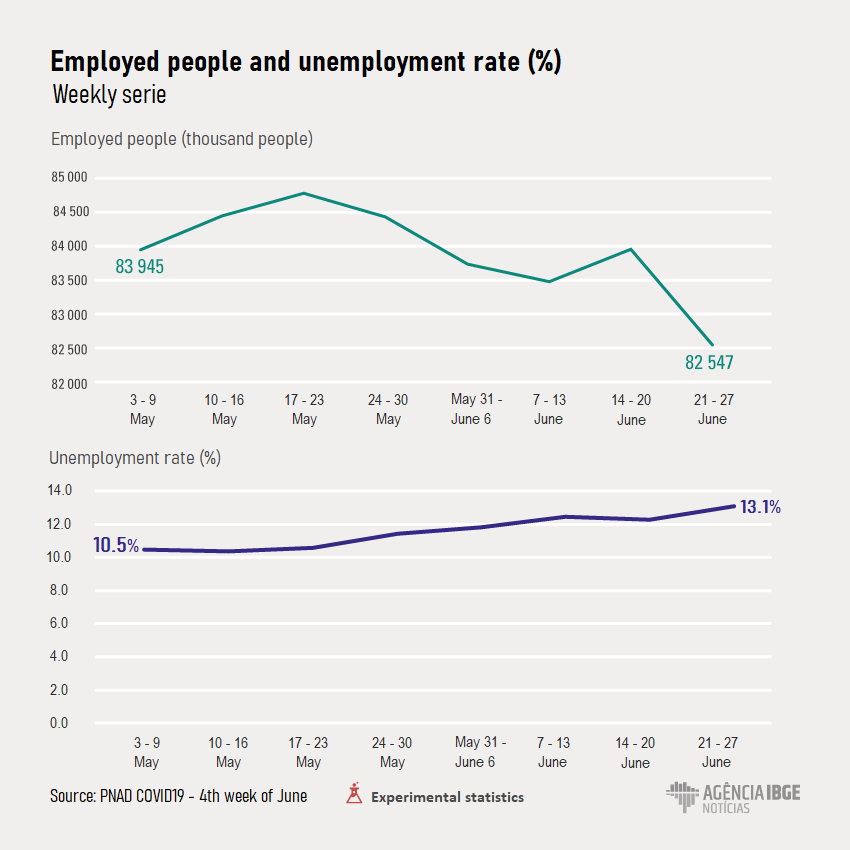PNAD COVID19
Unemployment rises to 13.1%, hits 12.4 million in 4th week of June
July 17, 2020 09h00 AM | Last Updated: July 20, 2020 10h26 AM

The unemployment rate increased to 13.1% in the fourth week of June over the previous week. It corresponds to 12.4 million unemployed persons. This is the highest rate since the beginning of May, when PNAD COVID19 started, and it results from the drop from 84 million to 82.5 million (-1.5 million) employed persons in the week. The data were released today (17) by the IBGE.
"In relation to the first week of May, the employed population also dropped, the unemployed population increased and so did the unemployment rate. The unemployed population searching for a job rose 26% compared with the first week of May," said Maria Lúcia Vieira, coordinator of the survey.

The survey also shows that the number of employed persons who were temporarily away from work due to social distancing remained falling in the fourth week of June, changing from 11.1 million to 10.3 million in the comparison with the previous week. They were 16.6 million in the beginning of May.
"This may be due to persons returning to work, but also due to a possible layoff of such persons from their jobs," analyses Vieira.
Among the employed persons, 8.6 million worked remotely, which represents 12.4% of the workers not away from their jobs due to the pandemic. This group remains stable since the first week of May (8.5 million).
The coordinator of the survey also notices the drop in the number of persons who were away from the workforce, but would like to work and did not search for a job due to the pandemic or lack of work in the locality where they live (17.8 million). "The pandemic is no longer the major reason that the persons allege for not searching for work," said her.
On the other hand, the rate of workers in the informality stayed at 34.5% in the fourth week of June, hitting 28.5 million persons. They were 29.9 million in the beginning of May.
Those employed in the private sector without a formal contract; domestic workers without a formal contract; employers who do not contribute to the INSS; self-employed workers who do not contribute to the INSS; and unpaid workers helping a resident or relative are among the informal workers.
In the fourth week of June, the IBGE estimates that 170.1 million persons were at working age, but only 82.5 million were employed, a figure lower than in that in the previous week (83.9 million) and in the first week of May (83.9 million). In other words, less than half (48.5%) of them were working in the fourth week of June.
15.4 million complain about some flu symptom for four weeks
Concerning the health data, Vieira highlights that the number of persons who complained about any symptom of flu syndrome remains statistically stable for four weeks in a row, about 15.4 million. Nevertheless, 26.8 million persons were symptomatic in the first week of May.
Most symptoms also remained stable in the fourth week of June compared with the previous one, with the exception of eye pain, whose complaints dropped from 1.9 million to 1.6 million. Headache was the most reported (7.2 million), followed by stuffy or runny nose (5.7 million), cough (4.8 million), muscle pain (4 million), sore throat (3.6 million), fatigue (2.2 million), loss of smell or taste (2 million) and difficulty to breathe (1.9 million).

Among the persons who had some of these symptoms, 3.1 million looked for medical care. 46.5% reported that they went to public health centers, 21.7%, to medical centers and 20.6%, to SUS hospitals. In the private network, 10.4% looked for private or military ambulatories or offices, 3.2% went to private medical centers and 11.5%, to private hospitals.

Altogether, 982 thousand persons looked for care in public, private or military hospitals, and 119 thousand were hospitalized.
Among the persons who had some symptom, 79.9% did not look for any assistance or health establishment in the fourth week of June. In contrast, 58.1% took medicines on their own. Another 13.1% took medicines under medical orientation. In addition, 4.3% called a health professional and 2.1% were visited by a SUS health professional.
PNAD COVID19 is a version of the Continuous National Household Sample Survey - Continuous PNAD, carried out with the support from the Ministry of Health, designed to pinpoint the impacts of the pandemic on the labor market and to quantify the persons with symptoms associated to the flu syndrome. The survey is released on a weekly and monthly basis by the IBGE. The survey comprises the Experimental Statistics.




















